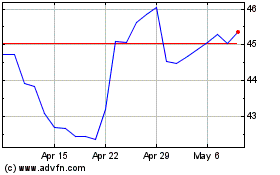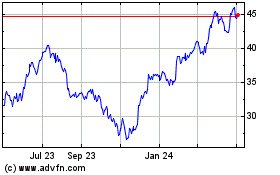U.S. Factory Production Rebounds in November -- 2nd Update
December 17 2019 - 10:43AM
Dow Jones News
By Harriet Torry
WASHINGTON -- U.S. factory production rebounded strongly in
November as auto industry output picked up after the General Motors
Co. strike ended.
Industrial production, a measure of factory, mining and utility
output, increased a seasonally adjusted 1.1% in November from the
prior month, the Federal Reserve said Tuesday.
That marked the biggest month-over-month increase since October
2017. Excluding motor vehicles and parts, industrial production
increased 0.5% last month and the manufacturing index rose
0.3%.
The jump in November output followed a spate of weak readings
and came after the United Auto Workers union ended its nationwide,
40-day strike at General Motors factories in late October.
October's industrial production was revised to a 0.9% decline
from a previous estimate of a 0.8% drop.
A separate reading on the U.S. housing sector showed
construction of new homes climbed in November, a sign of continued
momentum in the housing sector. The Commerce Department on Tuesday
said housing starts, a measure of U.S. home-building, increased
3.2% in November from October to a seasonally adjusted annual rate
of 1.365 million. Residential permits, which can be a bellwether
for future home construction, also rose 1.4% from the previous
month to a seasonally adjusted annual rate of 1.482 million.
The housing sector has strengthened this year following a slump
that began in late 2018. The National Association of Homebuilders
reported Monday that a gauge of home-builder confidence hit its
highest level in 20 years this month. The National Association of
Realtors will release data Thursday on November sales of previously
owned homes, which economists expect softened slightly from
October.
The longer-term manufacturing trend remains weak: from a year
earlier, industrial production declined 0.8% in November.
"Despite the GM-induced gyrations in recent months, the story
for the factory sector remains one of mild contraction in 2019,
hampered by trade tensions and a strong dollar," said Stephen
Stanley, chief economist at Amherst Pierpont, in a note to
clients.
Manufacturing output, which accounts for about 75% of the
nation's total industrial output, increased 1.1% in November, the
most since February 2018. That followed a 0.7% drop in both
September and October.
Mining production fell 0.2% last month, while utilities output
increased 2.9%. The mining index, which includes
oil-and-natural-gas extraction, was up 2% from a year earlier.
Capacity utilization, which reflects how much industries are
producing compared with what they could potentially produce,
increased by 0.7 percentage point to 77.3% in November. Economists
had expected 77.4%.
Tuesday's data is the latest to indicate the U.S. manufacturing
sector is beginning to stabilize after a tumultuous year marked by
trade uncertainty.
In addition to trade developments, oil prices are up about 30%
from a year earlier, a trend that could halt further contraction in
energy-related manufacturing. Auto makers also have labor
agreements in place, and the global economic slowdown doesn't
appear to be as severe as some feared.
Nonetheless, the Institute for Supply Management's manufacturing
index declined further in November, to 48.1 from October's 48.3.
Readings above 50 denote expansion, while those below 50 are a sign
of contraction.
Write to Harriet Torry at harriet.torry@wsj.com
(END) Dow Jones Newswires
December 17, 2019 10:28 ET (15:28 GMT)
Copyright (c) 2019 Dow Jones & Company, Inc.
General Motors (NYSE:GM)
Historical Stock Chart
From Aug 2024 to Sep 2024

General Motors (NYSE:GM)
Historical Stock Chart
From Sep 2023 to Sep 2024
